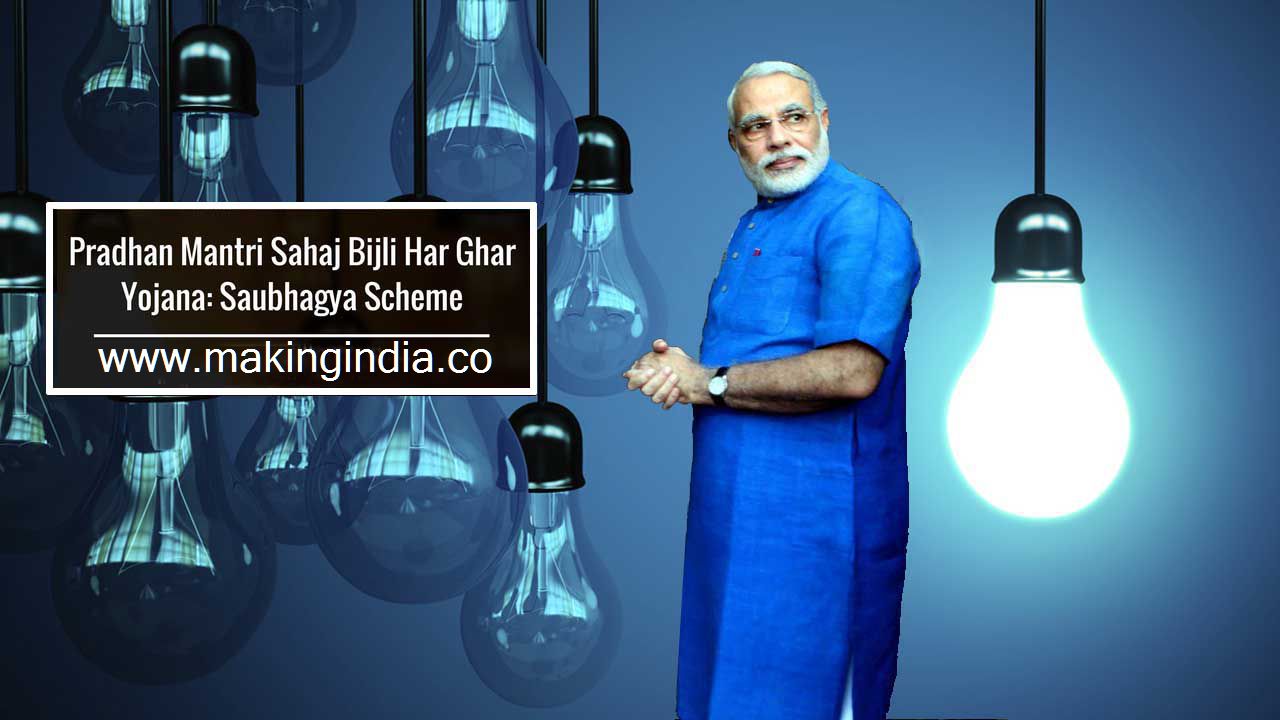
The Government launched the Saubhagya scheme or Pradhan Mantri Sahaj Bijli Har Ghar Yojana in September 2017.
The Saubhagya scheme was launched to ensure electrification of all willing households in the country. Under the scheme, power connection will be provided free of cost to all poor families.
Other households would also be provided electricity connections on payment of Rs.500 (which shall be recovered by the power distribution companies/power departments in 10 instalments along with electricity bills)
However, the scheme provides only free power connection. The cost of electricity consumption will have to be paid by the households.
- Objective: To achieve universal household electrification in the country by 31st December 2018.
- Plans to cover 40 million families.
- Outlay- Rs.16320 crore
- 60% of the outlay to be financed by Central Government, 10 % by the state and remaining by loans.
The Prime Minister had launched Deen Dayal Upadhyay Gram Jyoti Yojana in 2015. Under the scheme, 99.37% of villages have been electrified.
However, a village is declared to be electrified if 10% of the households are given electricity along with public places such as schools, panchayat office, health centres, dispensaries and community centres.
Hence, Saubhagya scheme was launched to provide electricity to all households.
A poor household cannot get an electricity connection for various reasons:
- It is not affordable.
- Lack of awareness on how to get a connection
- No electricity pole nearby which makes getting connection more expensive
Hence, Saubhagya was launched to plug such gaps and address the issues of entry barrier, last mile connectivity and release of electricity connections to all un-electrified households.
Under the scheme, prepaid and smart metering schemes will be installed in the households. The household will have to pay in advance for a fixed amount of electricity.
The Rural Electrification Corporation Limited will be the nodal agency for the operationalisation of the scheme throughout the country.
Drawbacks of the Saubhagya scheme:
- The poor faces two problems with respect to electricity- getting a connection and payment of subsequent bills. The scheme only solves the first problem and expects the poor to pay the electricity bills.
- The Government will find it challenging to manage additional power demand. Industry estimates suggest that this scheme would potentially require an additional 28,000 MW and additional energy of about 80,000 million units per annum, which is roughly 7% of India’s current installed power capacity.
Benefits of the Saubhagya scheme
As per the Government, the scheme would benefit in the following ways:
- Substitute use of Kerosene for lighting purposes resulting in a reduction in indoor pollution.
- Help in establishing efficient and modern health services in all parts of the country.
- A sense of enhanced personal safety especially for women and increase in post-sunset social as well as economic activities.
- Boost education services across all areas
- Quality lighting post-sunset would facilitate children to spend more time on studies and move ahead further in prospective careers.
- Household electrification also increases the likelihood that women would study and earn income.
The scheme would facilitate economic growth and employment generation:
- Substitution of use of Kerosene with electricity for lighting purposes would reduce annual subsidy on Kerosene and would also help reduce the import of petroleum products.
- Electricity in each home would provide improved access to all kind of communications like Radio, Television, Internet, mobile etc. through which everyone would be able to access all kind of important information available through these communication mediums
- Farmers can access information about new and improved agriculture techniques, agro-machinery, quality seeds etc. resulting in significant increase in agriculture production and consequently increase in income.
- Farmers and youths can also explore the possibilities of setting up agro-based small industries.
- Availability of reliable electricity services would also facilitate the establishment of new shops of daily use goods, fabrication workshops, flour mills, cottage industries etc. and such economic activities would generate direct as well indirect employment.
- Implementation of the scheme itself would result in employment generation in view of the requirement of semi-skilled / skilled manpower for execution of works of household electrification.
The expenditure of over Rs 16,000 crore will create positive externalities which will further help in generating employment and benefit the economy.
Other posts that you may like:
What is Universal Basic Income and is India ready for it?
Gold Monetisation & Sovereign Gold Bond Scheme: Explained
References:
Great information!
I love your blog
Thank you. Keep reading 🙂